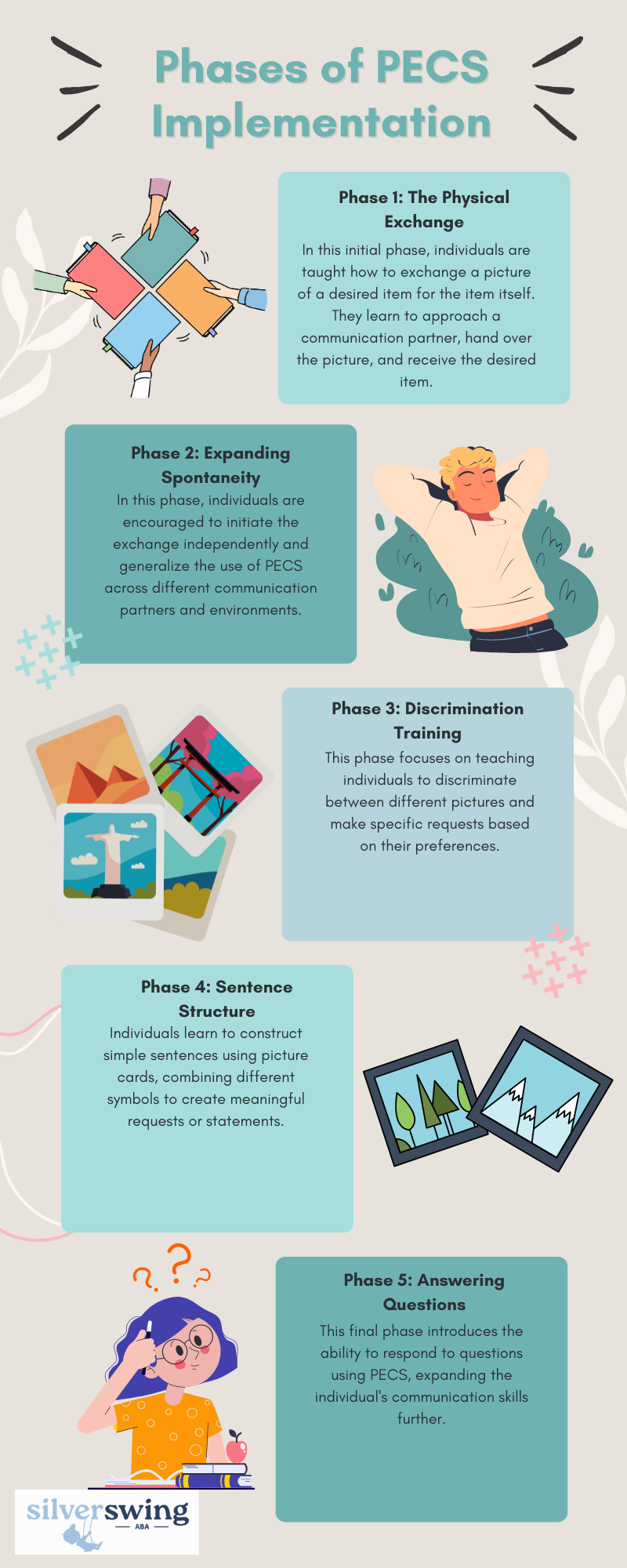Picture Exchange Communication System (PECS) is a widely recognized communication approach designed to support individuals with limited or no spoken language skills, particularly those with autism spectrum disorder (ASD). PECS allows individuals to communicate their needs, wants, and thoughts by using a series of pictures or visual symbols.
Let’s explore the introduction to PECS and the benefits it offers.

What is PECS?
PECS is a six-phase picture system based on the principles of applied behavior analysis (ABA). It was developed to empower individuals with autism to become effective communicators by encouraging them to initiate communication themselves. The system provides a structured and visual method for individuals to make requests, comment, and answer questions.
One of the key aspects of PECS is that it allows individuals to communicate without relying solely on spoken language. This is particularly beneficial for individuals with limited verbal skills or those who find it challenging to initiate communication through speech.
By using pictures or symbols, PECS provides an alternative mode of communication that is visual and concrete.
Benefits of PECS
PECS offers several benefits for individuals with autism and other communication difficulties. These are as follows:
- Facilitates Communication Initiation – PECS encourages individuals to become initiators of communication by teaching them to exchange pictures or symbols to express their needs and desires.
- Reduces Frustration – For individuals who struggle with speech, PECS provides a means to effectively communicate their wants and needs, reducing frustration and promoting independence.
- Increases Communication Skills – Through the use of PECS, individuals can develop and enhance their communication skills. They learn to associate pictures with specific objects or actions, expanding their vocabulary and understanding of language.
- Promotes Social Interaction – By using PECS, individuals can engage in social interactions more effectively. They can initiate conversations, respond to questions, and actively participate in social exchanges.
- Supports Speech Development – While PECS focuses on non-verbal communication, research has shown that some individuals using PECS have also developed speech. PECS can serve as a stepping stone toward speech development, as individuals gain confidence and expand their communication abilities.
PECS has been widely researched and has demonstrated positive outcomes in improving communication skills and reducing challenging behaviors associated with autism. The system has been implemented globally and has become an evidence-based practice in the field of special education and autism intervention.

How is PECS Implemented
Implementing the Picture Exchange Communication System (PECS) requires proper training, guidance, and consideration.
Implementing picture communication may be challenging for some individuals, and the guidance of an experienced Speech Language Pathologist (SLP) can be beneficial in this process. These professionals are trained to assess individual needs and provide appropriate strategies for implementing PECS effectively. They can offer valuable insights, troubleshoot challenges, and provide ongoing support throughout the journey of using PECS.
It is also important to note that many speech pathologists, occupational therapists, psychologists, physiotherapists, social workers, parents, and teachers have been trained in the Picture Exchange Communication System (PECS).
When seeking professional help or making appointments, it is recommended to inquire about their experience and expertise with PECS to ensure that they can provide the necessary support.
Phases of PECS Implementation
PECS follows a structured approach with several distinct phases. These phases guide individuals through the process of gradually developing their communication skills using picture exchange. The phases include:

Each phase builds upon the previous one, gradually enhancing the individual’s communication abilities and fostering independence in using PECS.
Cost Considerations
When considering the implementation of PECS, it is essential to be aware of the associated costs. The initial costs for the Picture Exchange Communication System can be significant, especially if attending specialized workshops or obtaining training materials. However, ongoing costs are generally low.
As of 2024, the cost for a 2-day PECS basic training workshop was approximately $695 for professionals and $440 for parents, as offered by National Autism Resources. These workshops provide comprehensive training and resources for individuals interested in implementing PECS effectively.
It is important to research and consider these costs, as well as explore potential funding options or resources available in your region to support the implementation of PECS.

PECS Effectiveness
The Picture Exchange Communication System (PECS) has been widely studied and has shown positive effects in enhancing communication skills for individuals with autism spectrum disorder (ASD).
Research findings and success stories provide evidence of the effectiveness of PECS in facilitating communication and improving the overall quality of life for individuals with ASD.
Research on PECS has predominantly focused on the early stages of implementation, which primarily involve teaching children how to use pictures to request items or activities. Studies have shown promising results in this area, indicating that PECS can effectively help children with ASD learn how to ask for things using visual aids.
While research has shown positive effects for the early stages of PECS, more high-quality studies are needed to investigate the effects of using PECS for more complex communication needs. Additionally, further research is required to determine which children respond best to PECS and to explore its efficacy in various contexts.
Success Stories
PECS has been implemented successfully worldwide with learners of all ages who have various cognitive, physical, and communication challenges. Success stories highlight the adaptability and effectiveness of PECS in different contexts, showcasing its ability to enhance communication skills and foster meaningful interactions.
By using the PECS approach, individuals with limited or no spoken language skills can have an alternative way to communicate their needs, wants, and thoughts. PECS empowers individuals to take charge of their communication, making the initial approach less intimidating since they are not expected to speak initially.
Furthermore, PECS has been found to increase communication skills beyond basic requests. Individuals with autism can learn to use PECS to make comments, answer questions, and engage in more complex exchanges.
This expansion of communication abilities facilitates social interactions and offers individuals with ASD a way to actively participate in conversations and express themselves.
The collective body of research findings and success stories supports the effectiveness of PECS in improving communication skills for individuals with ASD. While further research is needed to explore its full potential and its applicability to more complex communication needs, PECS stands as a valuable tool in augmentative and alternative communication (AAC) for individuals with autism.

PECS in Practice
The implementation of the Picture Exchange Communication System (PECS) has gained global recognition and has been successfully utilized in diverse settings. Additionally, it has proven to be effective across different age groups and learners with varying cognitive, physical, and communication challenges, highlighting its adaptability and positive impact.
PECS has been implemented worldwide. Its effectiveness in promoting communication and overcoming barriers has made it a valuable tool in supporting individuals with autism spectrum disorder (ASD) across different cultures and languages.
The flexibility of the PECS approach allows for customization to suit the specific needs of individuals, regardless of their location.
Age and Learner Diversity
PECS is designed to benefit individuals of all ages who experience challenges with communication. From young children to adults, the system has shown promise in improving communication skills and fostering independence. Learners with various cognitive, physical, and communication difficulties have successfully utilized PECS as a means of expression and connection.
The adaptability of PECS makes it suitable for individuals at different stages of their communication development. Whether someone is at the early stages of learning to communicate or has limited spoken language skills, PECS provides an alternative method for expressing their thoughts and needs.
By utilizing visual supports and a structured approach, PECS facilitates the growth of communication skills in individuals with autism.
By implementing PECS, individuals can enhance their ability to communicate effectively, leading to increased independence and improved social interactions. The use of matching picture symbols that accurately represent activities and concepts aids in making communicative messages more understandable. The systematic nature of PECS allows individuals to progress through the phases at their own pace, ensuring that the learning process is tailored to their specific needs.
PECS serves not only as a means of communication but also as a stepping stone towards further language development. It provides a foundation for individuals to transition to spoken language or augmentative and alternative communication (AAC) devices as their communication skills progress.
The global implementation and success of PECS across diverse populations and age groups attest to its efficacy as a visual communication system for individuals with autism. By embracing PECS, individuals with autism can overcome communication challenges and unlock their potential for effective communication and meaningful connections.




